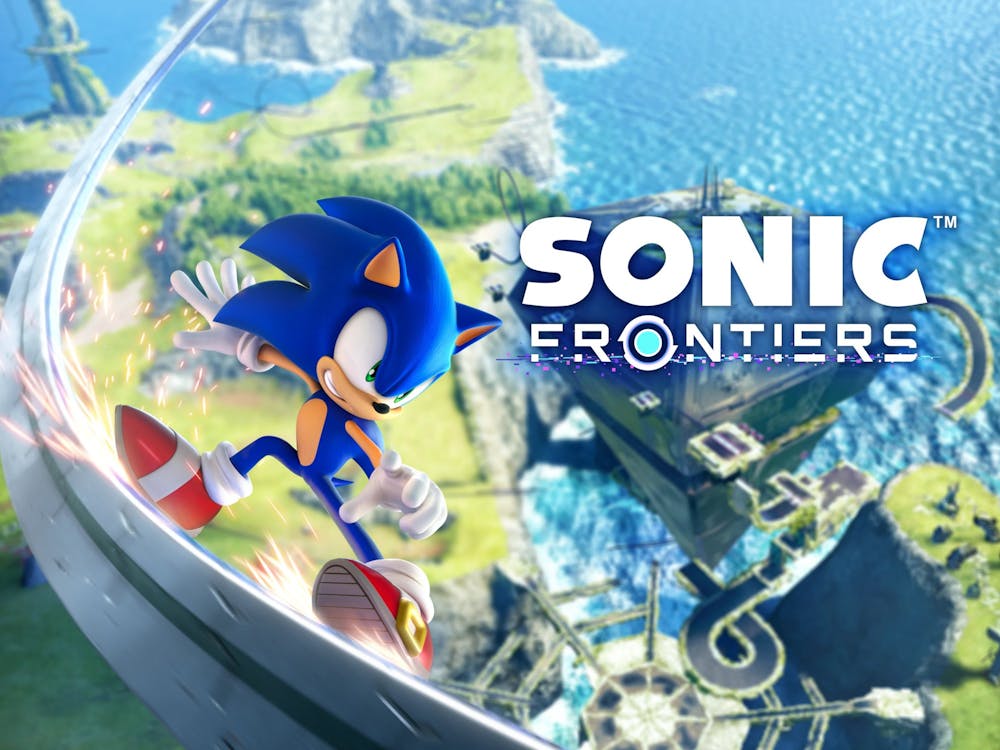Disclaimer: This review was conducted on a Nintendo Switch and played equally in portable and docked mode.
Sonic has had a rough transition to 3D. Or, at least that’s what I’ve heard. I’ve never actually played a 3D Sonic game before, despite the series making the jump all the way back in 1998 with Sonic Adventure. Besides 2017’s Sonic Mania I’ve never played any Sonic game before. Despite this, people have always told me that the series has a messy reputation. However, curiosity managed to get the better of me as I slowly paid more attention to the game in the lead up to launch and ultimately decided to give the franchise a try.
Super sonic gameplay
Sonic Frontiers features the franchise's new “open zone” gameplay system. This is effectively an open world Sonic game just with the open world cut into five islands, or zones. This new system is by far the highlight of Sonic Frontiers. Regardless of the game, I love feeling fast and hate slow gameplay. I’m also quite fidgety and am always looking for games where it’s fun to simply run around the world. Sonic Frontiers excels at giving me both. The controls take some getting used to, but once you do it becomes addictive to run across the islands without a thought.
Of course, thoughtless running isn’t all there is in the game. Each island is covered in all sorts of rails and bounce pads to create mini platforming stages. This is the heart of the open zone. Each bit of platforming is set up in a way where you can launch off the ending and either straight into the middle of another section or the start of one. It is unlikely more than a few seconds will ever be spent in the world without the option to do something.

The gameplay loop for most of the game is to run around the world killing minibosses to collect gears, using the gears to enter cyberspace levels to collect keys, using keys to collect Chaos Emeralds, and using the emeralds to beat the island’s boss. As previously touched on, the first leg of that is my favorite aspect of the game. Combat is surprisingly fluid, albeit simplistic. At first I was underwhelmed by the combat, as the game’s first encounters simply boil down to pressing the same button a few times until you win. Over time bosses become more complex and the combat reveals itself to be more about solving a movement puzzle or platforming challenge to hurt the boss. Every encounter is different and I think it was smart to set them up in this way as it is far more engaging than the combat itself.
The last part of the game I was universally impressed with was the music. Not just by the quality, which is superb, but by the quantity. Not only does each island have a unique theme, each miniboss, cyberspace level, and boss has its own track. Songs can be wildly different, slow piano keys denote the overworld while screaming metal accompanies each island boss. Despite how varied each song is, they all remained enjoyable to listen to.
Padding that can’t go fast
There is a lot going on in this game. At the end of each open zone platforming segment you might find a portal gear, a vault key, a power seed, a defense seed, some fishing tokens, or some memory tokens. There will probably be some Kocu, the local rocky inhabitants, for you to grab up as well. Lots of collectibles isn't necessarily bad, but some feel unnecessary. For example, Sonic has four stats that can be raised: speed, rings, power, and defense. Seeds raise their respective power and defense stats, and returning Kocu can raise either speed or rings. I feel like just one collectible to be used on every stat would be better, but it hardly detracts from the overall experience.
What is annoying is the method of how you raise the stats. Across each island are two NPCs, one who accepts seeds and one for the Kocu. The Kocu NPC doesn’t feel particularly playtested however. Unlike the seed NPC which automatically upgrades both stats to the max availability, you have to run through several lines of dialogue for each Kocu trade. It quickly becomes tedious to do and I ended up rarely bothering to actually upgrade either stat. If you decide you want to change how the speed and rings are divided you need to leave the NPC that deals with those stats and go to the seed NPC, which makes little sense.

This kind of padding and unintuitiveness seems to permeate the entire game. They couldn’t just have the open zone gameplay, they have to have cyberspace, supersonic titan fights, fishing, and random mandatory minigames. Sometimes the variety is good, like with the space invaders-style mini game and the island bosses. Sometimes it feels out of place and doesn’t match how Sonic controls, like Cyberspace and most mini games. Or sometimes it can just be pointless like fishing. This design extends to the story as well, where every encounter has to take place as a cutscene. Anytime Sonic talks to a character the game will pause, fade to black, run the cutscene, fade to black, and reload the game. Perhaps on an Xbox Series or PS5 the loading times are shorter, but on the Switch there were times it took longer to enter a cutscene than it took to actually watch the cutscene. The custom animations are nice, but ultimately I would have rather just had some voiced-over text boxes for the shorter, less important moments.
Beyond transitional annoyances the story was better than anticipated. It’s certainly nothing special, but there is enough quality there to set the stage and make me want to see what happened next rather than only run around the island. If you’re a long time Sonic fan I did get the impression the game has quite a lot to dig into, but for people not well versed in the series like me the plot can be easily followed and enjoyed.
Boosting into Cyberspace
The game’s pinnacle of unintuitive, unpolished game design are the Cyberspace levels. These are extremely short, corridor-style levels where the goal is to get from start to finish as fast as possible. They are remarkably similar to what I’ve seen people play in previous 3D Sonic games. A handful of these levels are thrilling to run through, and showcase what the mode could have been like. Unfortunately, most are more frustrating than they are worth.
I have to assume the games these levels are seemingly based on had controls designed to fit the level design, Frontiers does not. These levels are played with Sonic’s full open world range of control. It is remarkably easy to launch yourself clear beyond the stage with just a jump. This seems like such an avoidable issue because there are already scripted segments in the open zone that lock up Sonic’s controls to keep you on a linear path, a similar system could have been utilized here.
Cyberspace levels feel incredibly unpolished, which is unfortunately how I have to describe the entire game. Somehow, the game doesn’t feel built for going fast, despite that being the entire game. Far too often I would launch off a jump pad in the open zone, only for the camera to not keep up and I have to restart the section because I couldn’t see what was next. Or I would run up the leg of a towering enemy and randomly clip through them, getting launched across the map.
Popping in at the Speed of Sound
Finally, the game looks a bit dreadful. I know when playing a game on Switch there need to be limited expectations in terms of the visuals, but Sonic Frontiers is a bit excessive. The game has horrible pop in, anything beyond the immediate surroundings simply doesn't exist on screen. The ground covering that empty expanse is often nothing more than a glob of muddy pixels. Not that it can be seen anyway because the game runs at such a low resolution that Sonic almost never had a face during gameplay. The one saving grace is that the frame-rate was mostly consistent and never became unplayable.
Visuals are an aspect of a game that I’m able to overlook easiest, and that includes Sonic Frontiers. After a while I just became used to how the game looked and played it without trouble. But it still leaves so much to be desired when I’ve played countless open world games on Switch that look stunning.
Sonic Frontiers is an addictively fun game. I anticipate playing the game for countless more hours, maybe even a second playthrough. The Sonic Team created a rock solid foundation for the franchise’s reimagining. The title is let down through poor visuals, unclear direction for content, and a slew of bugs. Regardless, I am excited to see the future of the series or maybe just an update to make walls a bit more solid.

Sources:
Photos:
Venturebeat, Nintendo, Gameinformer
Contact Ryan Minter with any comments @Rnminterbsu.edu



















